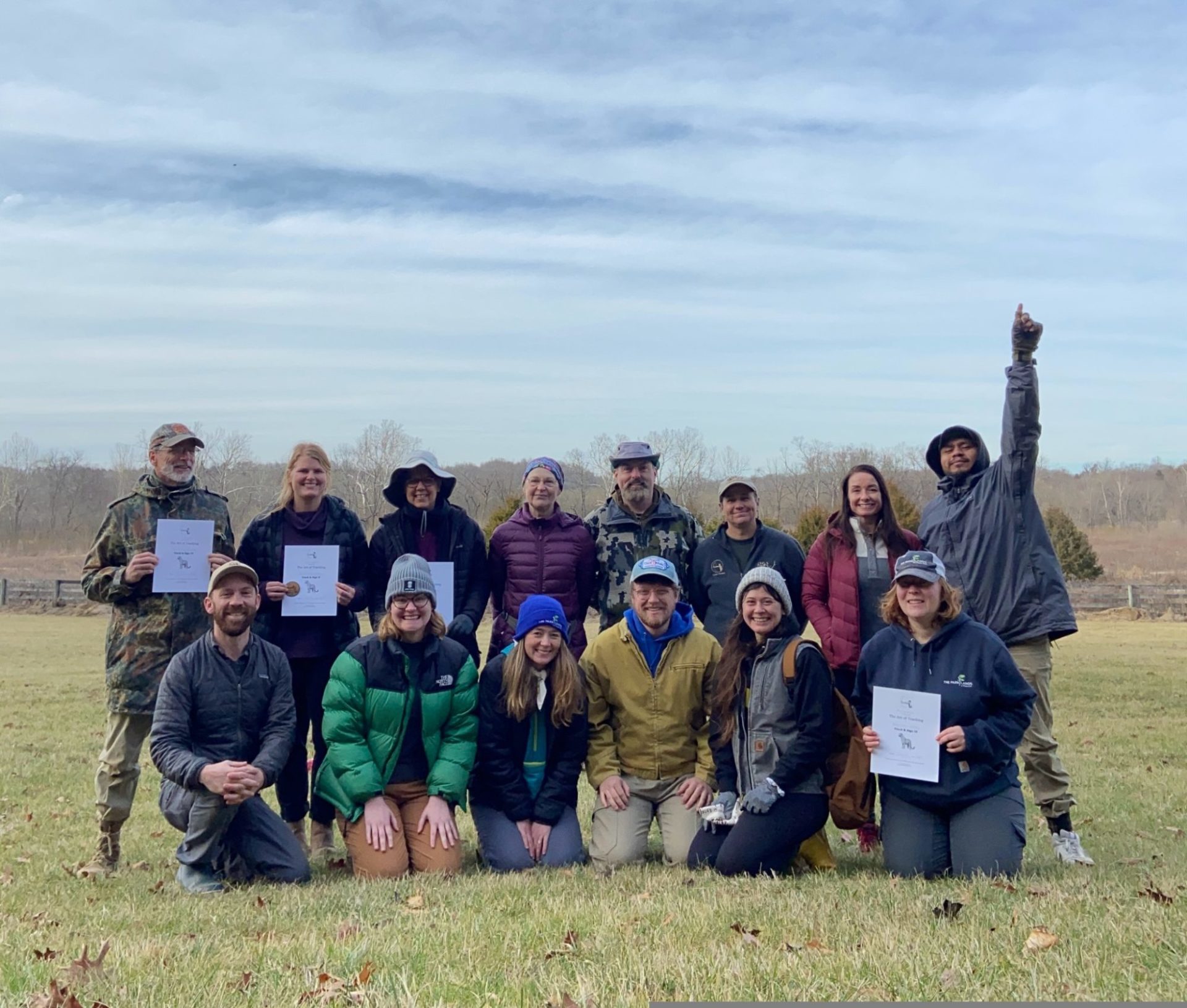
Reading the Secrets of the Forest
Beaver, Muskrat, Mink, Deer, Coyote, Fox, Skunk, Mouse, Bobcat, Pileated Woodpecker, Raccoon, Mourning Dove, Yellow Bellied Sapsucker, and many more all made their presence known as we hosted our first Standard Track and Sign Evaluation at the Parklands with Cybertracker North America this past February. Track and Sign is the science and art of interpreting marks on the land left by animals. Sometimes it is a simple task of identifying who left that track, or how fast they were moving, but other times it becomes an in-depth story and an intimate look into these animals’ secretive lives.
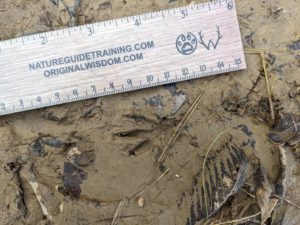
We were fortunate to host Marcus Reynerson as our skilled evaluator. While he lives in Washington state, he grew up in the Louisville area and has his own connection to the crisscross of streams that make Kentucky so special. Tracking is a growing community as it has proven its worth in areas of wilderness management, conservation, and scientific research. He has been my teacher for several years and helped me to understand the ecology of our landscape in a deeper way than I knew was possible.
Having worked at the Parklands for about 7 years in the Education Department, I have been lucky to glimpse a fair number of animals. Despite the many hours I have spent exploring the mosaic of habitats of the Parklands, animal sightings happen less than David Attenborough might have prepared you for. Many of our animals are nocturnal, many more are shy and evasive when it comes to humans. If you didn’t know any better, you might think these forests and meadows are sparsely populated. Being able to read their track and sign opens you up to understanding the astounding amount of activity that occurs across our quiet landscapes.
Evaluations are an intense 2 days, and it is hard to know what to expect. Our crew of participants were incredibly focused and creative as we answered 56 questions in 5 different locations. Our participants represented outdoor enthusiasts, hunters, and environmental educators from several locations around Louisville (including Jefferson Memorial Forest, Louisville Nature Center, and a few from our own Parklands Education Department!).
I had a few truly memorable moments but the most mind blowing happened early within the first batch of questions. Marcus led us down to a lovely 20-foot stretch of rich silty mud brought in from one of our winter floods. We tackled coyote, mink, mouse, bobcat, domestic dog, raccoon, and my favorite grey fox!
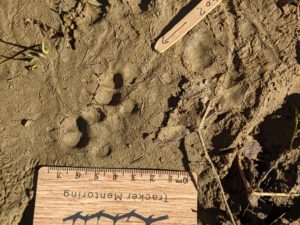
Grey foxes are an unusual animal that I can best describe as a dark grey mini version of a red fox and who have decided to act like cats instead of dogs. I’ve been convinced for years that we did not have grey fox in Louisville. While we are in the historic range and I knew it was possible, grey foxes are not very tolerant of people. Furthermore, we had no recorded sightings of grey foxes. However, plain as mud, we found clear and indisputable proof that grey fox roam our forest and stream edges in the form of dainty tracks.
Another favorite sign was a perfect pileated woodpecker scat. While most of us had never seen nor ever spent any thought about what pileated woodpecker scat might look like, many of us were able to decode the ant rich contents, the size, and the uric acid cap to understand this was from a large insectivorous bird.
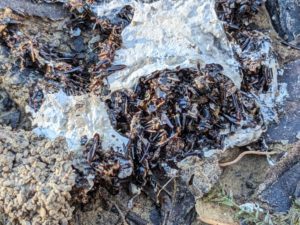
Perhaps most moving was the skeletal remains of twin 8-month-old white tailed deer. This was an in-depth question that had us considering how deer die in our landscape and ultimately the mortality that is both profound to the individuals and mundane in its commonness. While many of us considered the road nearby, the conclusion was that of a pair of coyotes doing what comes so naturally to coyotes in separating young defenseless deer and thinning our overpopulated herd. This question also helped us to understand what is knowable and what is not knowable from the signs that are left behind. What was knowable was how old the deer were when they died, who killed them, and how long ago that was. What was not knowable was whether their mother deer had died before the attack leaving them defenseless, whether she was alive but surprised by the attack, whether she fought back or if it was too quick for her to interfere. In uncovering parts of these stories, the forest still holds many more mysteries.
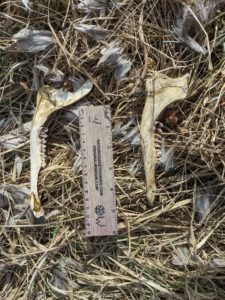
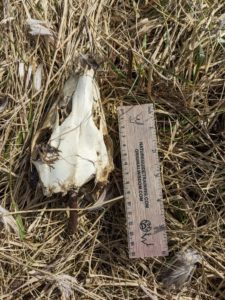
One important but surprising thing I have come to understand about where animals can be found is that not all land is used the same. Some microhabitats have only a few lone residents that can take advantage of the resources while other areas funnel dense numbers and a great diversity of animals.
The Parklands manage over 4000 acres of land, most of which is natural areas. This is a patchwork quilt of riparian forest, riparian meadow, oak savanna, marsh, upland forest, agricultural fields, and of course our streams. When you have two or more unique habitats pressed up against each other, you call that area ‘edge habitat.’ Edge habitat increases opportunities for animals to live there and indeed many studies find that edge habitat increases biodiversity and animals’ sightings. Many animals have needs that require different types of habitats either at different stages of their life or different habitats throughout the day. For instance, Pickerel frogs spend most of their adult life on the forest floor but move out of the forest into vernal pools, ponds, marshes, and stream backchannels in the spring to mate and lay their eggs. Pickerel Frogs need both forest and wetland at different stages of their life. Eastern Bluebirds live in the edge habitat between forest and meadow. The meadow provides the insect and seed forage material during the day, while the trees in the forest provide a safe place to sleep in the evenings. Eastern Bluebirds need forest and meadow every day.
When looking for animals or signs of animals, look to the edges. When I lead a hike, I even watch the slopes and angles that people prefer to walk. When you look even lower, you can see the tiniest of trails frequented by cottontails or voles. We all have our own unconscious patterns in our movements.
Four of our participants were able certify at different levels of tracking proficiency including Jim Hilgartner from Alabama, Olivia Kaiser from Louisville Nature Center, Ginny Delaney from Jefferson Memorial Forest, and myself. I know all of our participants, whether they certified or not, walked away with more knowledge and more appreciation for the everyday wonders around us. I am utterly grateful for my experiences with such intelligent, thoughtful naturalists who are every bit as invested in discovering the secrets in the forest as I am. I am utterly grateful for having such enthusiastic, tireless and expert teachers. I am excited to continue scratching out tracks and staring into the dirt.
